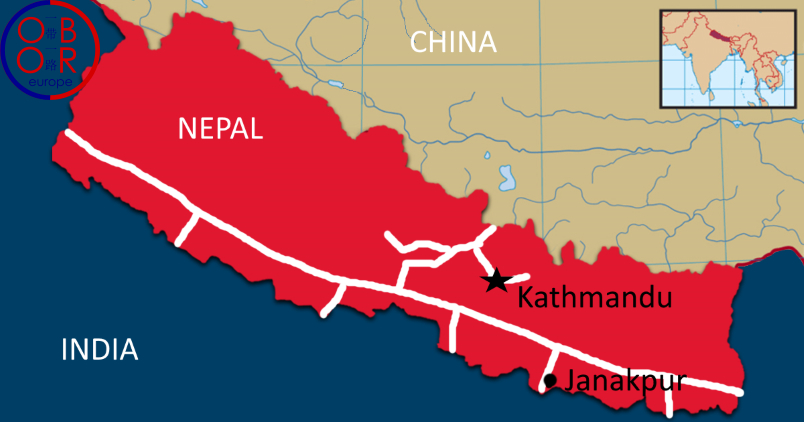by Natasha Fernando and Vijay Prasad Jayshwal

Nepal is a landlocked country sharing borders with India and China. It is a very popular destination for tourists trekking to see the Himalaya mountain range that forms a barrier between the Tibetan Plateau and the Indian Subcontinent. The geographical position of Nepal makes the country a buffer state interposed between the sub-systemic rivalries of China and India. The Sino-Indian threat perception dates back to the early 1960s mainly due to ongoing border skirmishes. The OBOR initiative offers Nepal a unique opportunity in connectivity to move beyond a land-locked status to become land-linked via better transport connectivity.
Nepal-China relations
Nepal-China relations were originally marked by religious ties with the visit of monks and scholars a common feature since the early 5th century. Official diplomatic relations were established in 1955 built on the mutual values of the Five Principles of Peaceful Co-existence: friendliness, understanding, mutual support, cooperation and respect for each other’s sensitivities. The two countries formalized their relations on 1 August 1955 by establishing diplomatic relations. Since the establishment of economic ties in 1956, China has provided Nepal with grants, interest free loans and concessional loans. The first such agreement was the ‘Agreement between China and Nepal on Economic Aid’ in 1956 spanning infrastructure construction, hydropower projects, healthcare and education etc. Beijing launched the BRI blueprint in 2013, however, it took almost five years for Nepal to formalize its own involvement in the BRI. In 2017, Nepal’s foreign secretary Shanker Das Bairagi and Chinese Ambassador to Nepal, Yu Hong signed the Memorandum of Understanding (MoU) on the Belt and Road Initiative (BRI) between Nepal and China.
The geographical proximity to China and India determines the direction of Nepal’s foreign policy. According to Rama Kant, cultural affinity and economics are not significant enough factors for Nepal-China relations. There is no significant Chinese community to influence decisions and Nepal has a small market for Chinese goods. In Nepal, the China-India relationship was influenced by domestic politics to a large extent. The Chinese favored the Nepali monarchy who were domestically supported by certain factions of communists. The Nepali Congress however was an India-backed party which opposed communists. The monarchy was overthrown in 2008 and today Nepal is a federal three tier government with a non-aligned foreign policy entrenched in the directive principles and the state policy of the Constitution.
OBOR (BRI) projects in Nepal
Nepal, being a land-locked country without access to the sea needs to look elsewhere for transport connectivity to facilitate its trade and commerce for development. OBOR will provide immense opportunities for Nepal in trade, business, tourism and commerce. As a positive catalyst to development, the BRI framework is welcomed in Nepal.
China has invested in road and railway projects. Investment opportunities include to energy, tourism, a free trade area, and irrigation with 35 projects coordinated through a Commercial Counselor Office in Kathmandu. Nepal shares a 1,415 km border with China. Between China and Nepal, there are 18 border crossing points that are in use as major trade routes. Among them, Kuti (Nyi-Lan), Kerrang (Ky-irong), are the most important ones. Other important border crossing points are Wollangchung, Khumbu, Tukuche and Karnali. The most important and difficult road entry between Nepal and China is the Rasuwa Gadhi-Kerong border crossing. Developing road and rail infrastructure in destinations such as Rasuwa where the Langtang National Park is located will be very beneficial for tourism as it is one of the most popular tourist destinations.
Nepal’s proposed railway network

Moving forward: Considerations for Nepal
According to scholar Hari Jha, Executive Director of the Centre for Economic and Technical Studies, in Nepal, it is still unclear how a developing country like Nepal could repay Chinese loans especially with China’s own fiscal and monetary limitations. The COVID-19 pandemic has hugely impacted the world economy and also the BRI. Baker McKenzie and Silk Road Associates forecast several possible scenarios. One is that China will focus on managing risks of supply chain disruption in the larger markets of Southeast Asia, improve digital value chains with Chinese technology companies and increase private sector engagement to address capital constraints for projects. For countries like Nepal, the involvement of international institutions to co-finance projects such as the World Bank, the European Investment Bank, the European Bank for Reconstruction and Development is an opportunity to neutralize any overdependence on China. These multilateral institutions are bound to impose certain rules, regulations, and standards to improve transparency in the development of the projects but Nepal has to come up with its own solutions to incentivize return on investments through tourism and business investment promotions.
The Nepal government has made several legislative changes to regulate BRI projects such as:
- The Industrial Enterprise Act 2016
- TheSpecial Economic Zone Act 2016
- The Policy for Intellectual Property Rights 2017
- The Foreign Investment and One Window Policy Act 2015
- The Public-Private Partnership Policy 2015
- The Foreign Investment and Technology Transfer Act 2018
- The Foreign Employment Policy 2012
- The Foreign Investment Policy 2071
- The Labor and employment Policy 2062
- The Land Acquisition Resettlement and Rehabilitation policy for Infrastructure Development Projects 2014
- The Private Financing in Build and Operation of Infrastructure Act 2006
Furthermore, Nepal has entered into Double Tax Avoidance Agreement with China to help reduce the tax burden of BRI development.
- For a long period of time, Nepalese foreign policy was defined by the interests of India due to criticism of the BRI from Southern parts of Nepal. Political division also favored the approach to some extent as the Congress party of Nepal supported a pro-India policy.
- Nepal is a small country in terms of population, size and geography which matters in international politics and relations. Domestic industries are not in a favorable position to compete with foreign goods and services especially to export markets under the BRI framework.
- Another important aspect of implementing the BRI in Nepal, are jurisdictional issues. Since the BRI involves many states and jurisdictions, there will be obvious disputes. Therefore clear dispute settlement mechanisms are needed.
The geopolitical tensions between Nepal, India and China may challenge the BRI. However, working out feasible solutions to the above considerations will help make the BRI work in the Indian subcontinent and especially for small states such as Nepal.
The views expressed in this article are those of thes authors, and do not necessarily reflect the views of OBOReurope.
Share the post "From landlocked to land-linked: OBOR in Nepal"
